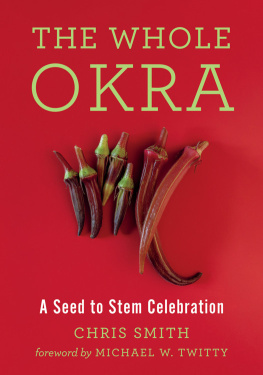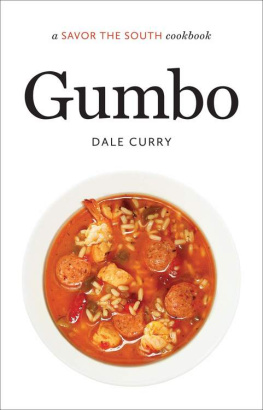a SAVOR THE SOUTHcookbook
Okra
SAVOR THE SOUTHcookbooks
Okra, by Virginia Willis (2014)
Pickles and Preserves, by Andrea Weigl (2014)
Bourbon, by Kathleen Purvis (2013)
Biscuits, by Belinda Ellis (2013)
Tomatoes, by Miriam Rubin (2013)
Peaches, by Kelly Alexander (2013)
Pecans, by Kathleen Purvis (2012)
Buttermilk, by Debbie Moose (2012)
2014 Virginia Willis
All rights reserved. Manufactured in the United States of America.
SAVOR THE SOUTH is a registered trademark of the
University of North Carolina Press, Inc.
Designed by Kimberly Bryant and set in Miller and
Calluna Sans types by Rebecca Evans.
The paper in this book meets the guidelines for permanence and durability of the Committee on Production Guidelines for Book Longevity of the Council on Library Resources. The University of North Carolina Press has been a member of the Green Press Initiative since 2003.
Library of Congress Cataloging-in-Publication Data
Willis, Virginia, 1966
Okra : a savor the South cookbook / Virginia Willis.
pages cm. (Savor the South cookbooks)
Includes bibliographical references and index.
ISBN 978-1-4696-1442-7 (cloth : alk. paper)
1. Cooking (Okra) 2. Cooking, American Southern style.
3. International cooking. 4. Okra. I. Title.
TX803.O37.W55 2014
641.65648 dc23 2013033254
18 17 16 15 14 5 4 3 2 1
To my sweet mama, Jenny B. Willis,
who taught me to love food and cooking
Contents
AFRICA
NORTH AFRICA AND THE MEDITERRANEAN
INDIA AND SOUTHEAST ASIA
THE CARIBBEAN AND SOUTH AMERICA
a SAVOR THE SOUTHcookbook
Okra
Introduction
ODE TO OKRA
Okra is a contentious vegetable. Its one of the most southern of vegetables and as much a part of southern cuisine as collard greens and field peas, but its far more controversial in the southern kitchen than those comforting, homey sides. Folks love okra or they hate it. No oneveritably no oneis in the middle.
Okra lovers passionately love okra in all manners of being, all shapes, forms, and means of preparation. Boiled, fried, steamed, grilled, broiled, pickled, raw, whole, sliced, juliennedyou name it, okra lovers love okra. Those who hate it think its slimy, gooey, and gummy. In my opinion, they just havent met the right okra.
As a southern food writer, I embrace my membership in the former camp. I love okra. I enjoy it cooked in a myriad of ways and combinations. And I love a challenge. I will cajole, entice, and seduce doubters into becoming believers. I rejoice in converting people to the joys of cooking, eating, and savoring okra. Im an okra missionary.
Okras Southern Connections
The recent upsurge in the popularity of southern cooking across the United States has brought renewed attention to okra. Chefs and home cooks across the country are exploring okra dishes far beyond gumbo. Heirloom okra seed packets are finding their way into the hands of gardeners all over the South. The long, slender, fingerlike pods of Red Burgundy; multicolored Hill Country Red okra, which is perfect for pickling; and short stubby pods of Star of David are joining the popular Clemson Spineless in the southern garden.
Okra thrives in the South. It loves the heat. The plant soars majestically as tall as ten feet high and produces large leaves and luxurious flowers that resemble hibiscus. Indeed, okra is a member of the mallow family, along with hibiscus, hollyhocks, and cotton, other familiar plants in our subtropical region.
Paper-thin, butter-yellow, wrinkled petals whirl together and are each punctuated with a brilliant dot of burgundy near the okra flowers center. Out of this shoots an erect stamen dusted with vibrant yellow pollen. Once unfurled, the petals wilt in the afternoon and usually fall to the ground the following day. The plant is sensual poetry.
Okra not only has an enticing flower, but its a seductive vegetable as well. No other vegetable in the southern garden shares its particular colors. Within the pods is a generosity of seeds, nestled in orderly fashion in chambers. The slender, curving fingers are covered with the palest, most delicate down. The plant is lush, fecund, and sultry yet hearty, robust, and sturdy. Okra is overtly feminine and masculine all at once. The plant seems to embrace adversity, tolerating poor soil as well as being among the most heat- and drought-tolerant vegetables. Okra willfully extorts the heat of a scorching southern summer like a Tennessee Williams character, making it a perfect match for the Deep South.
Culinary Uses
Okra can be prepared in a vast number of ways. I enjoy it stewed and so slick it barely needs chewing. Crisply fried, grilled with charred bits, roasted and chewy, or in a soup or stew, I love okra. I like to think of it as the next asparagus. Its only a matter of time before the love of okra spreads. Im convinced.
Okra is perhaps most famous as a common ingredient in the classic Louisiana dish, gumbo. (Okra helps thicken Creole gumbo; the other choice for thickening gumbo is fil, or sassafras powder.) It has a long history in Louisiana, where it was popular with the French colonists and thrives in the moist heat. Much of my childhood was spent in Louisianaperhaps thats where my love for okra took root. Or perhaps it was in my grandmothers kitchen, eating crispy, cornmeal-crusted fried okra.
Fried okra is a southern staple. When I was working in France for cookbook author Anne Willan, we once needed okra to test a recipe. It was nowhere to be found in the local markets, so we had to order a case from the French wholesale market Rungis, on the outskirts of Paris, only to use less than a pound! The gumbo was a huge disappointment, falling short of Annes strict standards. With the rest of the case, I made fried okra, using the only ground corn available in France at the time, fine polenta, for the coating. Anne called it popcorn-fried okra, and it was a huge hit. I can pretty much guarantee that this was the only time in history that fried okra was enjoyed as a snack with apritifs before dinner anywhere, much less in France. Another classic combination is okra and tomatoes. Its a natural marriage; the flavors, textures, and growing seasons are made for each other. In fact, these two classic southern treatments are found in almost every country that has okra in its cuisine, India, Greece, and Egypt included. Both combinations clearly work.
Historical References
Little is known about the early history and botanical distribution of okra, but its thought to have originated near the equator in Africa, in the area that includes present-day Ethiopia and the eastern portion of the Anglo-Egyptian Sudan. It eventually made its way into northern Africa, the Mediterranean, and India before its journey across the Atlantic to the New World. According to The New Encyclopedia of Southern Culture, enslaved Africans brought okra to the Americas during the era of the West African slave trade.
There are two primary theories on the etymology of the word gumbo. The first suggests that in Bantu, the language family of southern Africa, which includes Swahili, okra is called ngumbo, and this is where gumbo originated. The second is that gumbo comes from the Portuguese corruption, quingombo, for the word quillobo, the native name for the okra plant in the Congo and Angola.
Okra is found, however, in regions well beyond Africa and the American South. The ancient routes by which okra was taken from Central Africa to Egypt to the eastern Mediterranean and to India are not certain, but we do know that okra is found in abundance not only in the United States, but also in East Africa, India, and Southeast Asia. Its also found in pockets in the Caribbean, as well as in South America. One thing is for certainif the weather is hot, okra will grow.
Next page





![Willis - Beer: a cookbook: good food made better with beer: [recipes]](/uploads/posts/book/224368/thumbs/willis-beer-a-cookbook-good-food-made-better.jpg)








